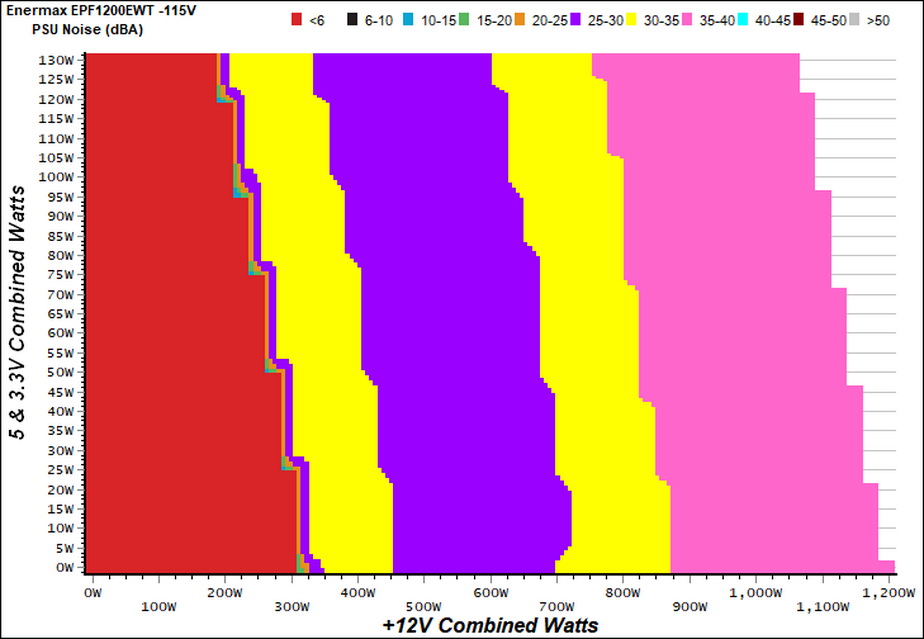Enermax Platimax D.F. 1200W PSU Review
Why you can trust Tom's Hardware
Efficiency, Temperature & Noise
Efficiency
Our efficiency testing procedure is detailed here.
Using results from the previous page, we plotted a chart showing the EPF1200EWT's efficiency at low loads, and loads from 10 to 110 percent of its maximum-rated capacity.
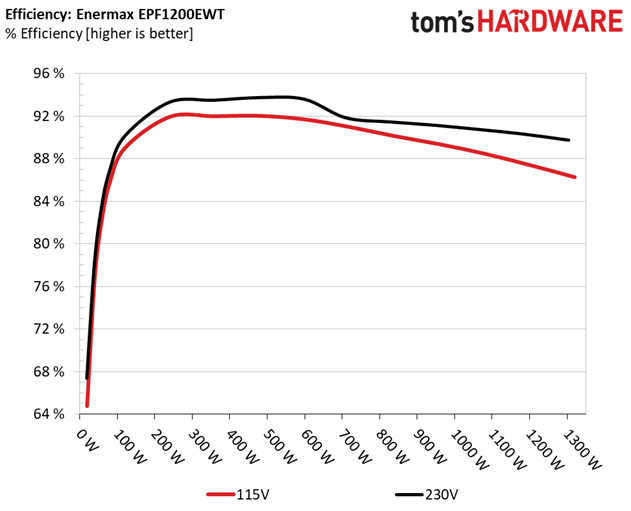
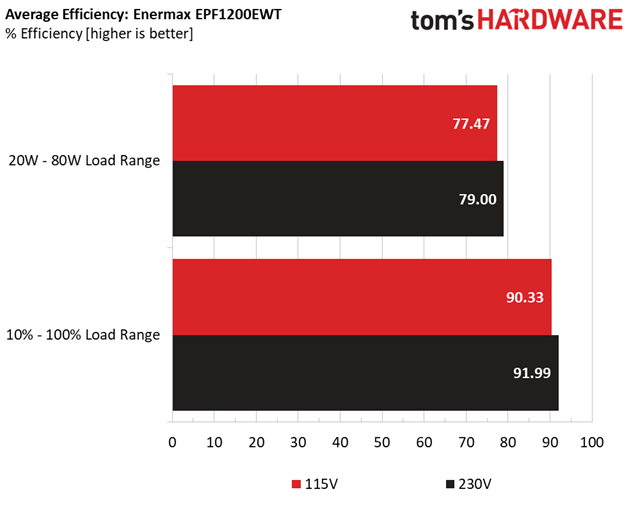
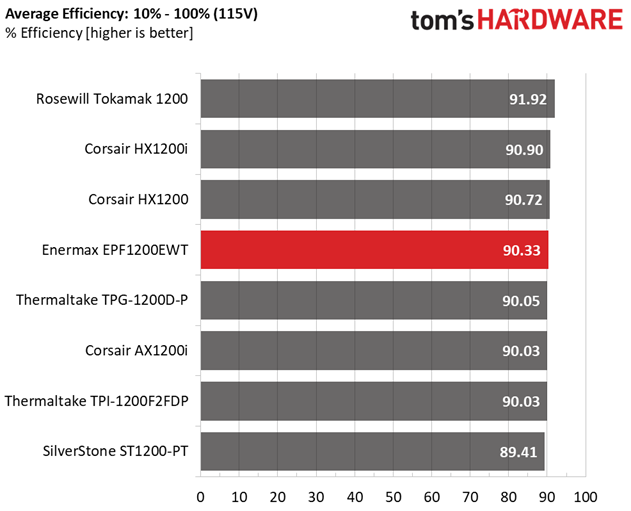
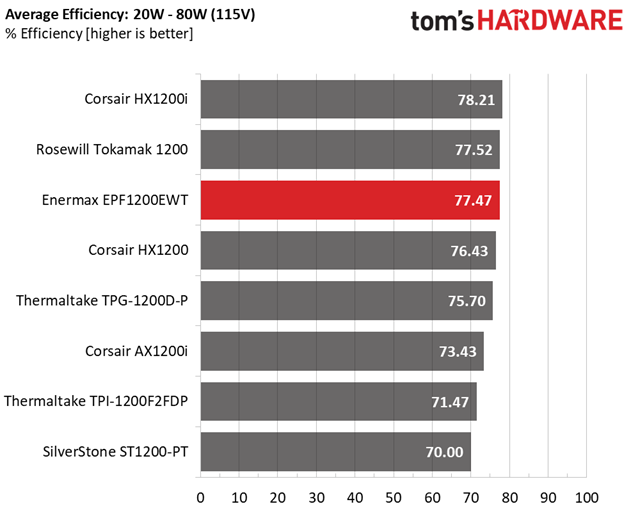
We notice a significant drop in efficiency with 230V input at around 650W load. This doesn't happen with 115V input. Though, under full load, the difference between 115 and 230V input is high.
Under normal loads, the EPF1200EWT lands around its competition, and it performs quite well with light loads.
Efficiency At Low Loads
In the following tests, we measure the EPF1200EWT's efficiency at loads significantly lower than 10 percent of its maximum capacity (the lowest load the 80 PLUS standard measures). The loads we dialed were 20, 40, 60, and 80W. This is important for representing when a PC is idle, with power-saving features turned on.
| Test # | 12V | 5V | 3.3V | 5VSB | DC/AC (Watts) | Efficiency | Fan Speed | PSU Noise | PF/AC Volts |
|---|---|---|---|---|---|---|---|---|---|
| 1 | 1.173A | 0.491A | 0.482A | 0.197A | 19.355 | 64.784% | 0 RPM | <6.0 dB(A) | 0.694 |
| 12.157V | 5.081V | 3.321V | 5.076V | 29.876 | 115.34V | ||||
| 2 | 2.431A | 0.983A | 0.993A | 0.395A | 39.835 | 76.890% | 0 RPM | <6.0 dB(A) | 0.873 |
| 12.152V | 5.080V | 3.320V | 5.072V | 51.808 | 115.31V | ||||
| 3 | 3.649A | 1.475A | 1.475A | 5.067A | 59.310 | 82.427% | 0 RPM | <6.0 dB(A) | 0.946 |
| 12.037V | 5.079V | 3.319V | 5.067V | 71.955 | 115.28V | ||||
| 4 | 4.919A | 1.968A | 1.989A | 0.790A | 79.797 | 85.774% | 0 RPM | <6.0 dB(A) | 0.968 |
| 12.035V | 5.079V | 3.319V | 5.064V | 93.032 | 115.26V |
For a PSU with 1.2kW capacity, the efficiency we observe is pretty good under such light loads.
In the table above, there's a huge voltage drop on the +12V rail with 60W load. The LLC resonant converter, which also controls the +12V FETs, either gets confused or is programmed (for some reason) to drop this rail's voltage closer to nominal once the load reaches 60W. Because we take a 40W load as point zero for our load regulation chart, though, the EPF1200EWT registers a notable deviation at +12V.
Get Tom's Hardware's best news and in-depth reviews, straight to your inbox.
5VSB Efficiency
The ATX specification, along with CEC, ErP Lot 3 2014 and ErP Lot 6 2010/2013, states that 5VSB standby supply efficiency should be as high as possible, recommending 75 percent or higher with 550mA, 1A, and 1.5A of load. The PSU should also achieve higher than 75% efficiency at 5VSB under full load, or with 3A if its max current output on this rail is higher than 3A.
We take six measurements: one each at 100, 250, 550, 1000, and 1500mA, and one with the full load the 5VSB rail can handle.
| Test # | 5VSB | DC/AC (Watts) | Efficiency | PF/AC Volts |
|---|---|---|---|---|
| 1 | 0.100A | 0.499 | 73.926% | 0.049 |
| 4.990V | 0.675 | 115.27V | ||
| 2 | 0.250A | 1.246 | 78.266% | 0.111 |
| 4.985V | 1.592 | 115.27V | ||
| 3 | 0.550A | 2.737 | 79.287% | 0.210 |
| 4.976V | 3.452 | 115.27V | ||
| 4 | 1.000A | 4.962 | 79.240% | 0.303 |
| 4.962V | 6.262 | 115.27V | ||
| 5 | 1.500A | 7.420 | 79.029% | 0.361 |
| 4.947V | 9.389 | 115.26V | ||
| 6 | 3.000A | 14.701 | 78.122% | 0.436 |
| 4.901V | 18.818 | 115.26V |
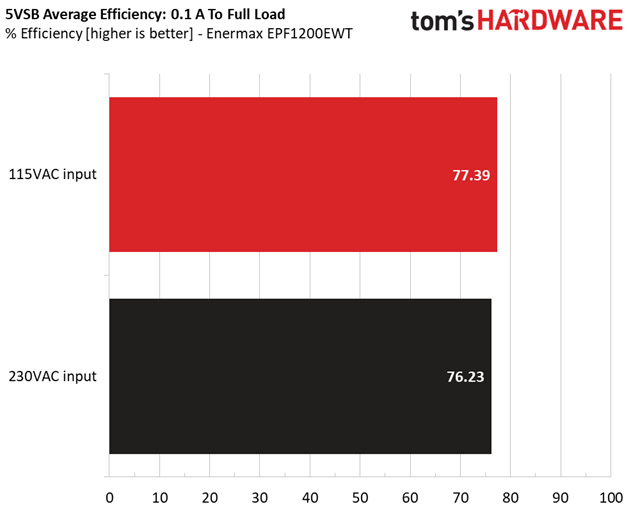
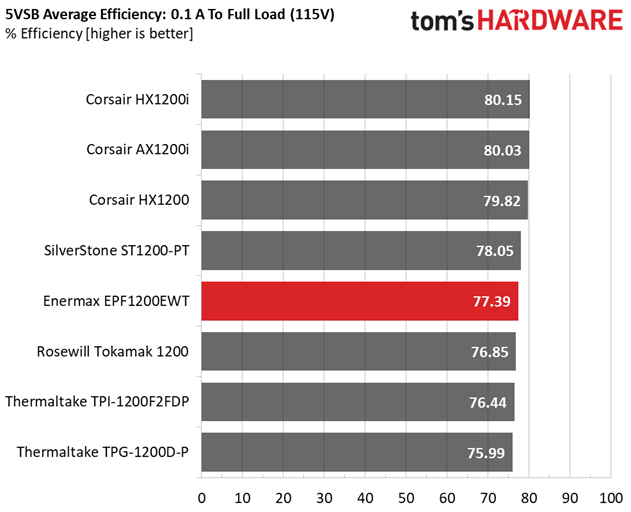
The 5VSB rail performs well. However, it is not as efficient as the CWT platforms used by Corsair's HX1200 and HX1200i.
Power Consumption In Idle And Standby
In the table below, you'll find the power consumption and voltage values of all rails (except -12V) when the PSU is idle (powered on, but without any load on its rails), and the power consumption when the PSU is in standby mode (without any load, at 5VSB).
| Mode | 12V | 5V | 3.3V | 5VSB | Watts | PF/AC Volts |
|---|---|---|---|---|---|---|
| Idle | 12.290V | 5.081V | 3.321V | 5.080V | 8.759 | 0.287 |
| 115.3V | ||||||
| Standby | 0.040 | 0.003 | ||||
| 115.3V |
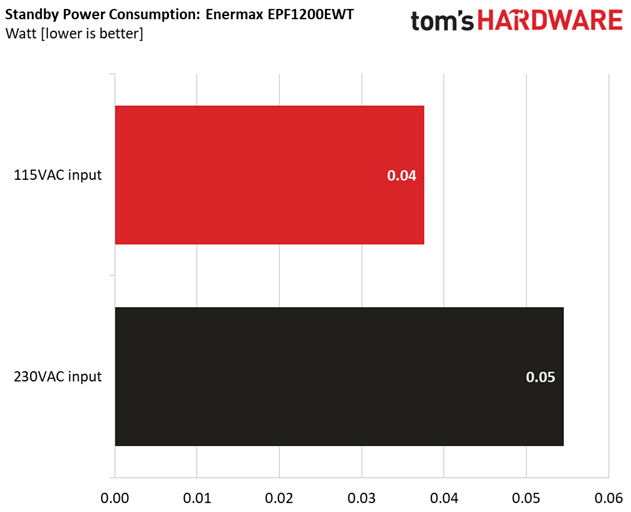
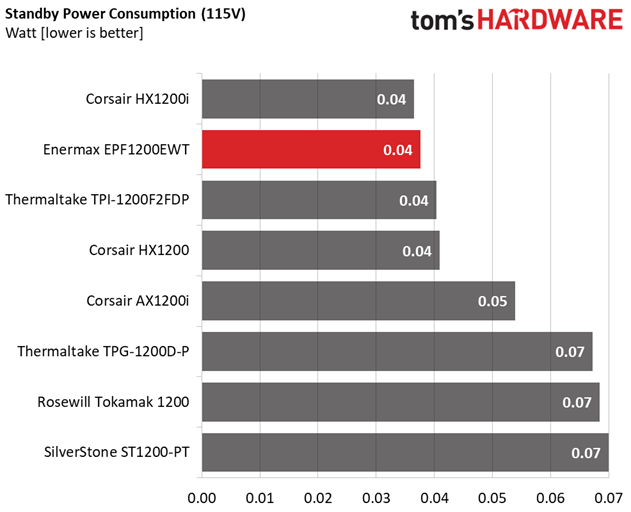
Vampire power is super-low with both voltage inputs.
Fan RPM, Delta Temperature, And Output Noise
Our mixed noise testing is described in detail here.
The first chart below illustrates the cooling fan's speed (in RPM), and the delta between input and output temperature. The results were obtained at 37°C (98.6°F) to 48°C (118.4°F) ambient temperature.
The next chart shows the cooling fan's speed (again, in RPM) and output noise. We measured acoustics from one meter away, inside a hemi-anechoic chamber. Background noise inside the chamber was below 6 dB(A) during testing (it's actually much lower, but our sound meter’s microphone hits its floor), and the results were obtained with the PSU operating at 37°C (98.6°F) to 48°C (118.4°F) ambient temperature.
The following graph illustrates the fan's output noise over the PSU's operating range. The same conditions of the above graph apply to our measurements, though the ambient temperature was between 30°C (86°F) and 32°C (89.6°F).
The semi-passive mode doesn't last long, and before long the fan is spinning pretty fast, generating more than 30 dB(A). It drops to 25-30 dB(A) for a while, and with more than 890W load at +12V, it goes into the 35-40 dB(A) range. Given its high capacity, this isn't a noisy PSU. However, the fan profile could be tuned better.
MORE: Best Power Supplies
MORE: How We Test Power Supplies
MORE: All Power Supply Content
Current page: Efficiency, Temperature & Noise
Prev Page Load Regulation, Hold-Up Time & Inrush Current Next Page Protection Features
Aris Mpitziopoulos is a contributing editor at Tom's Hardware, covering PSUs.
-
Soaptrail The DFR would not be that bad at adding dust to the case if it does it each time you start your PC. If DFR kicks in each time you resume from sleep i do not expect to see dust all over the case but if DFR is only activated once or twice a year then yes you will be adding dust to the case assuming it actually detaches from the PSU.Reply -
love4earthwk I'm afraid Teardown video is about thermaltake grand rgb.Reply
Enermax platimax df 1200w video is uploaded in Aris's youtube channel
https://www.youtube.com/watch?v=UYHaJDsd9QI -
Aris_Mp Yes there is a problem with the video. We are working on it! I am sorry for the confusion!Reply -
bettsar I prefer to read the teardown analysis. I usually find that to be the most interesting part of the power supply reviews. Thanks for the high quality work that you do in putting these together.Reply


